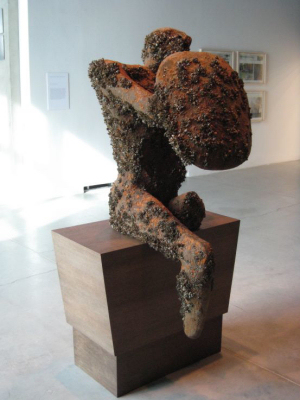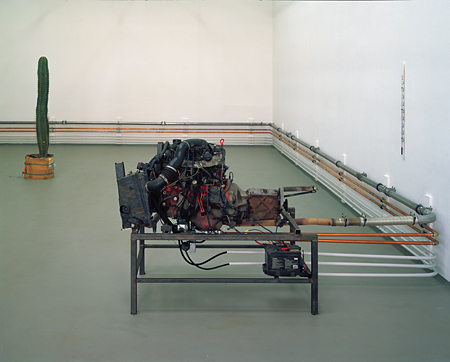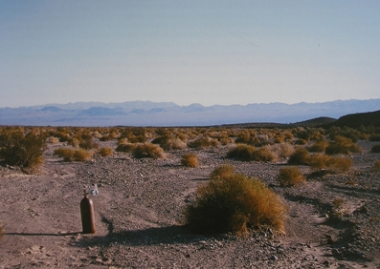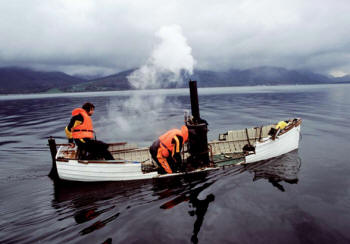|
|
| home | features | exhibitions | interviews | profiles | webprojects | gazetteer | links | archive | forum |
|
Simon Starling on submarines, modernism and clay-pits Interview by Rupert White at Tate St Ives
Yes. It never arrives.
So the steamboat eventually
sinks, and this gives it a tragic quality.
It has failure built-in.
Paired with Alfred Wallis' painting of a
steamship brings out the melancholy, I think because Wallis
himself is quite a tragic figure...
It's based on a comic cliché. One of the inspirations was
Tom and Jerry cartoons. Slapstick, self-destructive, Laurel and
Hardy-type thinking. Comedic and with a pathetic sense.
The work evolved out of a strip of water where the nuclear
submarines come and go up to Coulport and Faslane. And one of
the starting points for the work was the culture of protest
which has developed in response to it and this idea of
constantly keeping the nuclear deterrent as an issue in the
press by trying to stop a nuclear submarine with a canoe. These
are very dangerous and slightly self-destructive acts which
are all about dramatising that situation.
I had a really nice experience when I took my students from
Frankfurt to Scotland and we went to visit the submarine base,
but the PR guy kept interspersing his talk with slapstick
moments from British sitcoms as a kind of half-hearted attempt
to humanise what was going on there. It was a bizarre
counterpoint.
You hear this as an issue in the press: how should
scientists make science and technology understandable. And in fact this is
something that your work does in some ways.
That piece is a very open work. People bring their own
narratives to it. For some people it's very much about
unsustainable use of fossil fuels. Its a simple little narrative
structure that seems quite rich.
What determined your choice of pieces for the St Ives
show? There are themes to do with travel and materials, but
not as many references to Modernism as I expected.
Well there is Wagenfeld: German Bauhaus modernism. And there's
the Henry Moore piece in this show...
 Can
you explain how Modernism functions in your work? Can
you explain how Modernism functions in your work?
In the early days I used it as a set of coordinates for
orientating myself, temporarily and spatially. So wherever I
went in the world I found examples of international Modernism,
whether in Australia or wherever. It gave structure to my
travels, like a pilgrimage.
I lived for ten years in Glasgow, which in some ways is a
provincial situation for an artist. The geography of the practice
developed out of that and being very aware and self-conscious
about my position in the world, and what it meant to travel and
to operate on the peripheral.
Henry Moore has also been useful in that respect because he's
everywhere. These bronze things falling from the sky! They're
everywhere you go. He was the first British artist to have that
kind of global career.
He become a surrogate for my own travels, so wherever you go you
find him. I made this project in Toronto which was a replica of
one of his sculptures which was one of the first of his works to
go to America in the 50's, called Warrior with Shield. I made a
steel version of that which I put in Lake Ontario for 18 months.
It
grew zebra mussels on it, and I fished it out and exhibited it.
Moore's sculpture was inspired by a pebble that he had found on
the beach originally.
Have the mussels stayed on the sculpture? Surely they
just fall off when they die...
No they're still there. There is a conservator working hard to
make that happen!
It was about thinking about Moore and his relationship to the Cold War and
the way he was instrumentalised by politics, and also, the way he played
with that.
I understand that some of the Canadians were
resentful of Moore...
Yes. I think some of them thought 'why is our museum spending so
much money on a British artist?'
So themes of cultural colonialism also come to the
fore. And that's another important element in your work.
The provincial versus the global. There was this word that
was used the 'glocal': the combination of the global and the
local, and in a way there's always that in my work. The mapping
that's going on is very much of that kind.
The show is about following one or two threads in the work,
through to some sort of an end point. So it's often about
starting with an idea for some local project, so to say, then
tracking the ideas back through the practice and thinking 'that could
be interesting in relation to this'.
I love exhibition making. There's art-making but exhibition
making is a big tool of the artist.
 People
talk about environmental art or ecological art. Your work is not
always thought of in this context. People
talk about environmental art or ecological art. Your work is not
always thought of in this context.
Maybe but I've been in a lot of 'green' shows in the last few
years. Some of them have been great.
It's a difficult genre because environmental art is
not easy to define. It can be anything.
Yes. There has been a rash of those exhibitions popping up
around the world. But it seems to be dying down about now.
Some people have this idea that environmental art has
to depict nature or the natural world, but your work still seems
environmental without really doing this so much. It seems very
much about exploring historical and technological processes as
if they are themselves, giant organisms or ecosystems.
The work itself is ambiguous. It's not always politically
correct in relation to these things. Like the work that I made
in Germany with the cactus from the south of Spain where I used
the engine from my Volvo to create a heating system to keep the
cactus warm in Northern Germany in the winter (Kakteenhaus
(picture above left)).
You see this car engine chugging away in the back of the gallery...  How
overtly political should an artist be? How
overtly political should an artist be?
I like the work to engage with political and economic ideas, but
not to do so in a didactic way. I'm not a preacher. I'd feel
uncomfortable with that. But those things are very much there or
thereabouts in the work I'm making. I often talk about a balance
between poetics and politics and finding common ground between
them. But I'm cautious of work that deals directly with
politics, because there are better mechanisms for doing that.
I've read that you admire the simplicity in works
like Robert Barry's inert gas pieces (picture above right). But
your work is different. It has a complexity, both aesthetically
and conceptually, and I wonder if this is conscious on your
part: that you seek to embrace complexity.
There's a complexity. But at another level there is a simplicity
that relates to Barry. His whole practice was about not making
anything. The dematerialised artwork. It was about mediation as
much as making. Which is something I find interesting, but I'm
also very interested in stuff. And the inert gas piece is about
stuff; about matter.
Some of the works, like the poster stack of photos of the clay
pits made for the St Ives show, is a fantastically simple work.
What did you make of the clay pits in St Austell?
They're funny things. I've driven through Cornwall many times,
and I've never really seen them. They're like the backside of
the county. They're quite alarming. They're brutal in a way.
Episodes of Dr Who and the
like have been filmed there...
I
saw an image of an amazing Western that was filmed in the middle
of Paris when they were building the Centre Pompidou. There was
a huge crater there and a French filmmaker made a Western, and
it looks like Texas, with ramps coming down and so on. It's really
beautiful. You can see Paris in the background and he didn't
care about that. It was a really great transposition. Really
beautiful...
|
|
|

